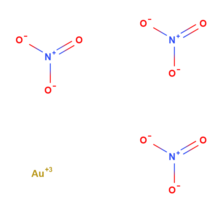Chemistry:Gold(III) nitrate
From HandWiki

| |
| Names | |
|---|---|
Other names
| |
| Identifiers | |
3D model (JSmol)
|
|
| ChemSpider | |
| EC Number |
|
PubChem CID
|
|
CompTox Dashboard (EPA)
|
|
| |
| |
| Properties | |
| Au(NO3)3 | |
| Molar mass | 382.98 g/mol |
| Appearance | Yellow crystalline solid |
| Reacts | |
| Related compounds | |
Related compounds
|
Nitroauric acid |
Except where otherwise noted, data are given for materials in their standard state (at 25 °C [77 °F], 100 kPa). | |
| Infobox references | |
Gold(III) nitrate is a yellow-colored chemical compound with the formula Au(NO3)3. The name gold(III) nitrate usually refers to the acid, nitroauric acid even in chemistry texts due this compound easily reacting with water.[1]
Production and reactions
Gold(III) nitrate is produced by the reaction of powdered gold and hot pure nitric acid:[2]
- Au + 4HNO3 → Au(NO3)3 + NO + 2H2O
It is important that there is no water because the gold(III) nitrate reacts with water and nitric acid to form nitroauric acid.
Related
Complexes containing gold(III) nitrate are also known, such as the tetraammine.[3][4]
References
- ↑ Arthur Messinger Comey (1896) (in en). A Dictionary of Chemical Solubilities Inorganic (2nd ed.). the University of Michigan: Macmillan & Company. p. 250.
- ↑ Ripan R., Chetyanu I. (1972). Inorganic chemistry. Chemistry of metals. 2. Moscow: World.
- ↑ Manfait, Michel; Alix, Alain J.P.; Kappenstein, Charles (January 1981). "Raman and infrared studies of the square planar tetraammine gold(III) nitrate and its deuterate". Inorganica Chimica Acta 50: 147–152. doi:10.1016/S0020-1693(00)83735-4.
- ↑ Skibsted, L. H.; Bjerrum, Jannik; Frederichsen, P. S.; Nakken, K. F. (1974). "Studies on Gold Complexes. I. Robustness, Stability and Acid Dissociation of the Tetramminegold(III) Ion.". Acta Chemica Scandinavica 28a: 740–746. doi:10.3891/acta.chem.scand.28a-0740.
Salts and covalent derivatives of the nitrate ion
| HNO3 | He | ||||||||||||||||
| LiNO3 | Be(NO3)2 | B(NO3)−4 | C | NO−3, NH4NO3 |
O | FNO3 | Ne | ||||||||||
| NaNO3 | Mg(NO3)2 | Al(NO3)3 | Si | P | S | ClONO2 | Ar | ||||||||||
| KNO3 | Ca(NO3)2 | Sc(NO3)3 | Ti(NO3)4 | VO(NO3)3 | Cr(NO3)3 | Mn(NO3)2 | Fe(NO3)3, Fe(NO3)2 |
Co(NO3)2, Co(NO3)3 |
Ni(NO3)2 | Cu(NO3)2 | Zn(NO3)2 | Ga(NO3)3 | Ge | As | Se | Br | Kr |
| RbNO3 | Sr(NO3)2 | Y(NO3)3 | Zr(NO3)4 | Nb | Mo | Tc | Ru | Rh | Pd(NO3)2 | AgNO3 | Cd(NO3)2 | In | Sn | Sb(NO3)3 | Te | I | Xe(NO3)2 |
| CsNO3 | Ba(NO3)2 | Hf | Ta | W | Re | Os | Ir | Pt | Au | Hg2(NO3)2, Hg(NO3)2 |
Tl(NO3)3, TlNO3 |
Pb(NO3)2 | Bi(NO3)3 BiO(NO3) |
Po | At | Rn | |
| FrNO3 | Ra(NO3)2 | Rf | Db | Sg | Bh | Hs | Mt | Ds | Rg | Cn | Nh | Fl | Mc | Lv | Ts | Og | |
| ↓ | |||||||||||||||||
| La(NO3)3 | Ce(NO3)3, Ce(NO3)4 |
Pr | Nd(NO3)3 | Pm | Sm | Eu(NO3)3 | Gd(NO3)3 | Tb(NO3)3 | Dy | Ho | Er | Tm | Yb | Lu | |||
| Ac(NO3)3 | Th(NO3)4 | Pa | UO2(NO3)2 | Np | Pu | Am | Cm | Bk | Cf | Es | Fm | Md | No | Lr | |||

